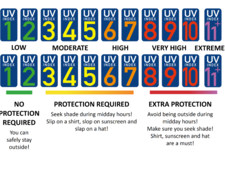-
Topics
Subnavigation
Topics
Electromagnetic fields
- What are electromagnetic fields?
- High-frequency fields
- Radiation protection in mobile communication
- Static and low-frequency fields
- Radiation protection relating to the expansion of the national grid
- Radiation protection in electromobility
- The Competence Centre for Electromagnetic Fields
Optical radiation
- What is optical radiation?
- UV radiation
- Visible light
- Infrared radiation
- Application in medicine and wellness
- Application in daily life and technology
Ionising radiation
- What is ionising radiation?
- Radioactivity in the environment
- Applications in medicine
- Applications in daily life and in technology
- Radioactive radiation sources in Germany
- Register high-level radioactive radiation sources
- Type approval procedure
- Items claiming to provide beneficial effects of radiation
- Cabin luggage security checks
- Radioactive materials in watches
- Ionisation smoke detectors (ISM)
- Radiation effects
- What are the effects of radiation?
- Effects of selected radioactive materials
- Consequences of a radiation accident
- Cancer and leukaemia
- Hereditary radiation damage
- Individual radiosensitivity
- Epidemiology of radiation-induced diseases
- Ionising radiation: positive effects?
- Radiation protection
- Nuclear accident management
- Service offers
-
The BfS
Subnavigation
The BfS
- Working at the BfS
- About us
- Science and research
- Laws and regulations
- Radiation Protection Act
- Ordinance on Protection against the Harmful Effects of Ionising Radiation
- Ordinance on Protection against the Harmful Effects of Non-ionising Radiation in Human Applications (NiSV)
- Frequently applied legal provisions
- Dose coefficients to calculate radiation exposure
- Links
UV measurement in Hamburg: more regional data for better UV protection
Federal Office for Radiation Protection expands its UV measuring network in Hamburg
Year of issue 2024
Date 2024.05.02
Date 2024.05.02

![]() The measuring station in Hamburg is part of the nationwide solar UV measuring network
Source: Haßelbusch/Deutscher Wetterdienst
The measuring station in Hamburg is part of the nationwide solar UV measuring network
Source: Haßelbusch/Deutscher Wetterdienst
Against the backdrop of climate change, protection from the harmful UV radiation of the sun is becoming increasingly important in many cities. The Federal Office for Radiation Protection (BfS) is expanding its UV measuring network in order to provide citizens with even better information about the current UV exposure in their city and protect them from skin cancer. Together with the Ministry of Justice and Consumer Protection of the Free and Hanseatic City of Hamburg, the BfS is putting a new UV measuring station into operation in Hamburg just in time for the start of the Hamburg Harbour anniversary.
The new measuring probe is located in the immediate vicinity of the Landungsbrücken on the roof of the Deutscher Wetterdienst (German Meteorological Service) building. It determines the current UV index from sunrise to sunset. In northern Germany, the index can reach values of up to 8 in the summer months. Protection from solar UV radiation is necessary from a value of 3. Since 6 May, the measurement data of the probe have been available on the websites of the BfS and the City of Hamburg.
"UV radiation is a risk to health. Although the general population is aware of this, it is often underestimated – as we know from surveys. The UV index can help with risk assessment, particularly when taking part in sports and other leisure activities. The UV index also provides guidance on sun protection measures. If you stay informed, you can protect yourself and enjoy the summer"
, says BfS President, Inge Paulini.
"The nationwide UV measuring network includes around 40 locations. The nearest station to Hamburg is Lüneburg. Now our city is getting its own UV measuring station. The risk of UV radiation is often underestimated. With more accurate regional data for Hamburg, we are now improving the service for people who live here or are visiting the city. This means you can find out even more about the current UV exposure"
says Anna Gallina, consumer protection senator of Hamburg.
Current UV measurement data also for football fans from all over the world
Hamburg will be one of the ten host cities for the 2024 European Football Championship from 14 June to 14 July. The BfS would also like to inform fans about the UV index and UV protection with the extended service as part of the European Championships.
The UV index was defined by the WHO and is an internationally standardised measure that indicates the intensity of the sun's UV radiation on the Earth’s surface on a scale of 1 to 11+. Recommendations for sun protection are assigned to certain value ranges:
- For values from 1 to 2, no protective measures are required.
- For values from 3 to 7, protective measures are required: seek shade during midday hours, wear protective clothing, a hat, and sunglasses, and use sunscreen with a sufficient sun protection factor (SPF).
- For values of 8 and above, the exposure is quite high, and protective measures are absolutely necessary. For example, it is best not to be outside at midday, to seek shade during the day, to wear appropriate clothing, hats and sunglasses, and to use sunscreen with a sufficient SPF.
Since 2006, the BfS has published the UV Index based on the measured data of the German UV measuring network on its website. The UV measuring network is an association of several institutions and authorities, which together now operate 42 stations. This makes the German UV measuring network a leader in international comparison.
The UV measurement data can be accessed at www.bfs.de/uv-aktuell. The City of Hamburg will also make the current daily schedule available at www.hamburg.de/sonnenbaden.
State of 2024.05.02







